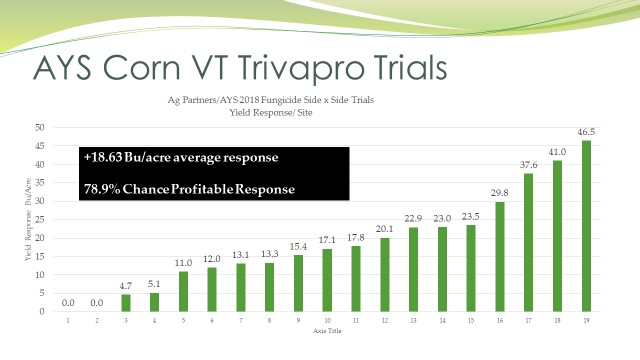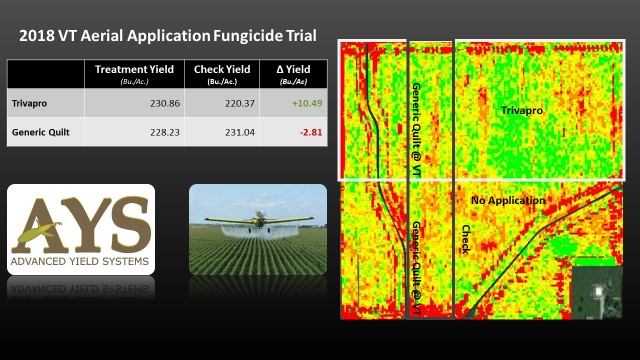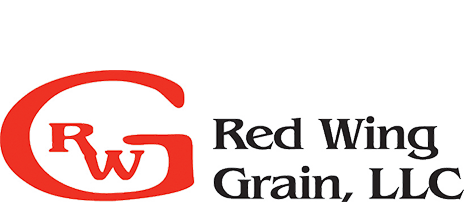By Joe Dee Joe.Dee@agpartners.net
It’s that time of the year again to sit down with your agronomist to go over what worked and what didn’t this year on your farm. Trying to make decisions in light of the current economic situation that we find ourselves in can be challenging. With the 2019 planning season in full force, it’s important to make educated decisions based off of good information and data to back it up. This includes a conversation about fungicide application and its Return on Investment (ROI).
Your first question might be why, why use a fungicide in corn and in soybeans? Well, a fungicide first works by controlling a broad-spectrum of diseases while increasing plant health and efficiency. If you can reduce the amount of stress on a plant, then you can allow it to maximize grain-fill by putting more energy toward producing yield instead of fighting diseases. Not only do we see extended disease control and plant health benefits when using a fungicide, but also much improved harvest-ability especially in years with the increased number of wind events/tornadoes in our area.
As I mentioned earlier, making educated decisions based off of good data is critical. This is where our Advanced Yield Systems (AYS) program comes into play. We are using information from local areas and compiling the data to show the value that these side-by-side trials have given us in 2018. With Trivapro at VT or tassel, AYS data has shown an average of 18.6 bushel response in 2018, (as shown below) a valuable return on investment.
Now taking a look at soybean fungicide response with Trivapro at R3, we have seen an average of 5.7 bushel/acre. Application timing in soybeans is essential for plant health and disease management. We generally don’t see foliar disease issues until that R3 growth stage or beginning pod. The best timing for soybeans is approximately in that R2 or full flower to R4 or full pod. I would recommend erring on the earlier side than later as far as timing goes.
Many factors can contribute to a positive fungicide ROI. Some of it can depend on the disease risk, crop rotation, hybrid response, or application timing. For instance, a lot of talk is generated on corn and whether an early V5 or the later VT application is better? Both timings can work well but the goal is different. Spraying at VT our goal is protecting the factory we built, protecting the ear leaf and leaves above the ear that supply most of the energy needed for grain fill. The longer we can keep the plant protected and healthy in the reproductive stage, the better chance for a more consistent return. Spraying at V5 our goal is building the best plant we can to produce the ear. V5 application is to promote early season health of the roots and the crown. In saturated soils we see high chances of crown rot and anthracnose so with this application we are increasing the probability of our best yield potential. The highest probability of ROI of a single application is at VT but a single application or a combination of both together have worked but keep in mind ROI from a one or two applications depends on what your limiting factors mentioned above are and the yield level you’re going for.
Corn hybrid response is another major contributing factor. Choosing the right hybrid can mean the difference between a 10 bushel response and a 20 bushel response. How do you know which hybrids have the best response? With brand data, Answer Plot data, and our own AYS data, our AYS team has developed a handy chart (below) to help us make better decisions on hybrids in our relative area.
When the decision has been reached to use a soybean and corn fungicide, what product do you use? There are many different products in the marketplace right now, and our main focus product is Trivapro by Syngenta. Reason being, it features Solatenol which provides extended residual control for longer season plant health benefits. It is honestly the hardest working, longest lasting fungicide for both corn and soybeans giving you the best preventative and curative disease control over other competitive products as shown below over a generic Quilt product.
When it comes to fungicide, you pay for what you get and Trivapro gives you that extra punch with longer residual. Talk to your local agronomist about using Trivapro on your farm this 2019 growing season!







